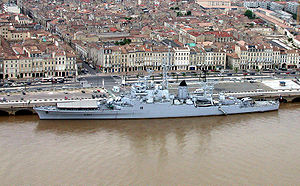French cruiser Colbert (C611)
 |
|
| History | |
|---|---|
|
|
|
| Name: | Colbert |
| Namesake: | Jean-Baptiste Colbert |
| Ordered: | 1953 |
| Builder: | Brest |
| Laid down: | December 1953 |
| Launched: | 24 March 1956 |
| Commissioned: | 5 May 1959 |
| Decommissioned: | May 1991 |
| Homeport: | Brest |
| Fate: | Awaiting disposal |
| General characteristics (as built) | |
| Type: | Cruiser |
| Displacement: | 9,085 t (8,942 long tons) standard, 11,093 t (10,918 long tons) full load |
| Length: | 180.47 m (592 ft 1 in) |
| Beam: | 20.31 m (66 ft 8 in) |
| Draft: | 7.9 m (25 ft 11 in) |
| Propulsion: | 2 × CEM-Parsons turbines, 2 shafts, 87,000 hp (64,876 kW) |
| Speed: | 33 knots (38 mph; 61 km/h) |
| Range: | 4,000 nmi (7,400 km) at 25 kn (29 mph; 46 km/h) |
| Complement: |
|
| Armament: |
|
| Armour: |
|
| Aircraft carried: | 1 helicopter |
| General characteristics (1972) | |
| Type: | Guided missile cruiser |
| Complement: |
|
| Armament: |
|
Colbert (C 611) was an anti-air cruiser, later transformed into a missile cruiser, of the French Navy. She was the sixth ship (and second cruiser) of the French Navy to be named after Jean-Baptiste Colbert (the previous one was scuttled at Toulon in 1942). She served in the Navy from 1956 to 1991, before being converted into a museum ship at Bordeaux from 1993. Colbert was scrapped in 2016.
Her construction began in the Brest dockyards in 1953. She was designed as a powerful ship, the second of the De Grasse series, able to overcome all threats solely by her guns' weight of fire - she had 57 mm and 127 mm turrets for a firing rate of one shot per second. Launched on 24 March 1956 in Brest, France, starting her trials on 5 December 1957 and officially entering active service on 5 May 1959, she was made part of a 15-ship squadron, with the main aims of protecting aircraft carriers from air attack, shore bombardment for ground operations, command hub for naval operations and evacuating French expatriates from overseas. In 1964 a naval reorganisation made her the flagship of France's Mediterranean squadron (escadre de Méditerranée) at Toulon, which was mainly made up of complementary units such as aircraft-carriers and frigates.
Her role as a foreign representative of France was important. In 1961 she repatriated the remains of Marshal Hubert Lyautey and she ferried General De Gaulle both on his 1964 South American tour and on his June–July 1967 official visit to Canada (the latter trip was the occasion of his famous "Vive le Québec libre speech" - the diplomatic row which followed put an end to the trip). During the Atlantic crossing on board Colbert De Gaulle signed a number of decrees, such as n°67-611 (23 July 1967, on interpreters in the army reserve) and n°67-612 (on interpreters in the naval reserve). Colbert also represented France at the bicentennial festivities in Australia in 1988.
...
Wikipedia
